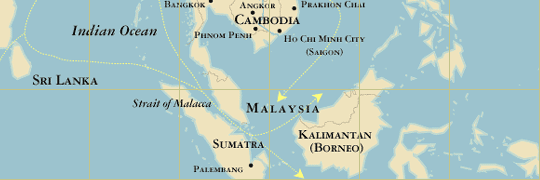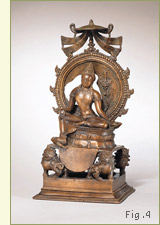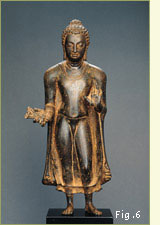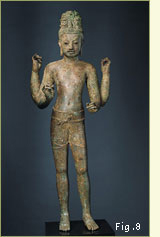|
|
|



 
   
Thailand
Although Thai tradition, like the Burmese, claims that Buddhism was introduced to the region by Ashoka's missionaries in the third century B.C.E., recent archeological evidence suggests that Buddhist missionaries established themselves much later, in the second century C.E. Thai objects in the Asia Society collection come from the  country's three broad geographical and cultural zones: the central region, the northeastern and eastern region, and the peninsula in the south.(Fig. 4), which was produced in Thailand under the aegis of the Shrivijayan empire. From roughly the sixth to the ninth century, Thailand's central regions were ruled by the Mon peoples. This area is often referred to as Dvaravati, although Dvaravati's borders and whether it was a kingdom or group of kingdoms are unknown. Theravada Buddhism was the Mon peoples' principal religion, country's three broad geographical and cultural zones: the central region, the northeastern and eastern region, and the peninsula in the south.(Fig. 4), which was produced in Thailand under the aegis of the Shrivijayan empire. From roughly the sixth to the ninth century, Thailand's central regions were ruled by the Mon peoples. This area is often referred to as Dvaravati, although Dvaravati's borders and whether it was a kingdom or group of kingdoms are unknown. Theravada Buddhism was the Mon peoples' principal religion,  although Mahayana Buddhism was also practiced by the seventh century, and with it came the depiction of bodhisattvas. While buddha figures produced by the Mon maintain the idealized formulas and underlying symbolism developed in India (Fig. 6), ethnic traits characteristic of the Mon are always manifest, particularly in the facial features (Fig. 7) Buddhist art from the peninsular region is represented by the Mahayana Buddhist sculpture of the Bodhisattva Manjushri discussed in the previous paragraph. although Mahayana Buddhism was also practiced by the seventh century, and with it came the depiction of bodhisattvas. While buddha figures produced by the Mon maintain the idealized formulas and underlying symbolism developed in India (Fig. 6), ethnic traits characteristic of the Mon are always manifest, particularly in the facial features (Fig. 7) Buddhist art from the peninsular region is represented by the Mahayana Buddhist sculpture of the Bodhisattva Manjushri discussed in the previous paragraph. Buddhist art from northeastern Thailand, an area crisscrossed by ancient land routes, shows stylistic influences from Dvaravati, pre-Angkor Cambodia, as well as the Cham kingdom that was located on the eastern shore of present-day Vietnam. Cambodian influence was at its strongest in eastern Thailand as this region was often under the rule of Cambodia in the pre-Angkor period, and later, in the eleventh and twelfth centuries, by Cambodian Khmer kings. An image of the Bodhisattva Maitreya (Fig. 8) shows the early influence of Khmer art on that of the Mon, particularly in the image's square-jawed face and inlaid eyes. Buddhist art from northeastern Thailand, an area crisscrossed by ancient land routes, shows stylistic influences from Dvaravati, pre-Angkor Cambodia, as well as the Cham kingdom that was located on the eastern shore of present-day Vietnam. Cambodian influence was at its strongest in eastern Thailand as this region was often under the rule of Cambodia in the pre-Angkor period, and later, in the eleventh and twelfth centuries, by Cambodian Khmer kings. An image of the Bodhisattva Maitreya (Fig. 8) shows the early influence of Khmer art on that of the Mon, particularly in the image's square-jawed face and inlaid eyes.
Back | Next
|
|
